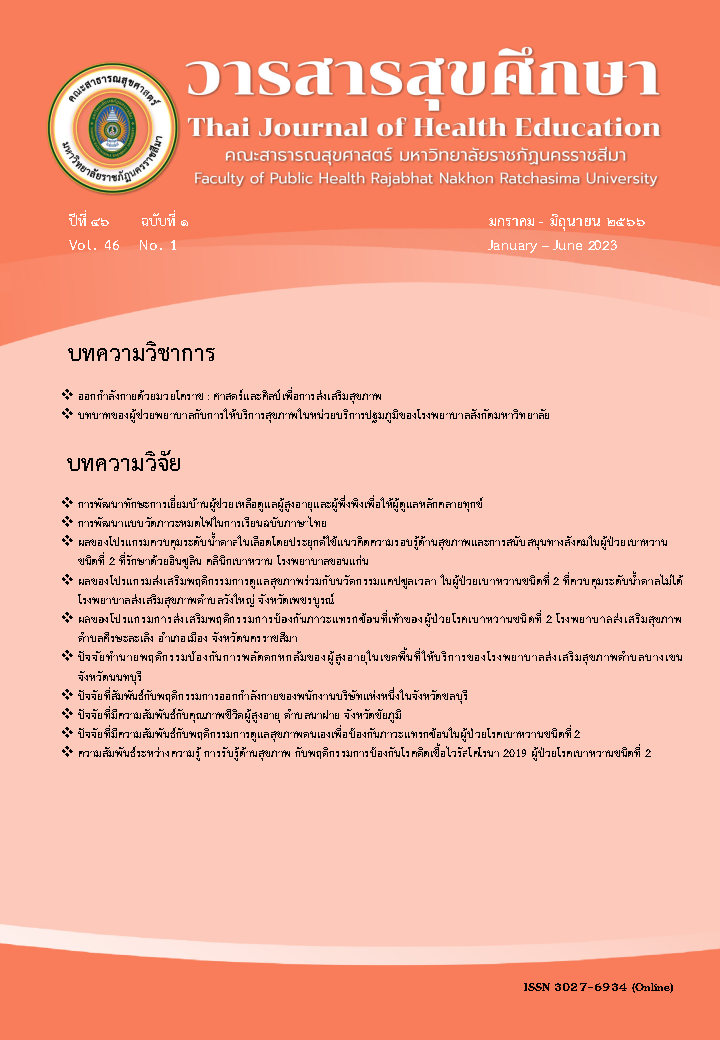ผลของโปรแกรมส่งเสริมพฤติกรรมการดูแลสุขภาพร่วมกับนวัตกรรมแคปซูลเวลา ในผู้ป่วยเบาหวานชนิดที่ 2 ที่ควบคุมระดับน้ำตาลไม่ได้ โรงพยาบาลส่งเสริมสุขภาพตำบลวังใหญ่ จังหวัดเพชรบูรณ์
Main Article Content
บทคัดย่อ
โรคเบาหวานเป็นปัญหาสาธารณสุขทั่วโลก และการควบคุมระดับน้ำตาลในเลือดไม่ได้ก่อให้เกิดภาวะแทรกซ้อน การวิจัยนี้ มีวัตถุประสงค์เพื่อศึกษาผลของโปรแกรมส่งเสริมพฤติกรรมการดูแลสุขภาพร่วมกับนวัตกรรมแคปซูลเวลา ในผู้ป่วยเบาหวานชนิดที่ 2 ที่ควบคุมระดับน้ำตาลไม่ได้ โรงพยาบาลส่งเสริมสุขภาพตำบลวังใหญ่ จังหวัดเพชรบูรณ์ เป็นการวิจัย
กึ่งทดลองสองกลุ่ม จำนวน 70 คน กลุ่มทดลอง และกลุ่มเปรียบเทียบ กลุ่มละ 35 คน กลุ่มทดลองจะได้รับโปรแกรมที่ผู้วิจัยสร้างขึ้น ระยะเวลา 10 สัปดาห์ ได้แก่ กิจกรรมบรรยายประกอบสื่อ เรื่องการรับประทานอาหาร การใช้นวัตกรรมแคปซูลเวลาในการรับประทานยา การจัดการความเครียด การออกกำลังกาย การดูแลความสะอาดร่างกาย และการพบแพทย์ตามนัด การแลกเปลี่ยนความรู้ ส่วนกลุ่มเปรียบเทียบได้รับการรักษาตามปกติ เก็บรวบรวมข้อมูลโดยใช้แบบสอบถามก่อนและหลังการทดลอง วิเคราะห์ข้อมูลเปรียบเทียบความแตกต่างของคะแนนเฉลี่ยภายในกลุ่ม และระหว่างกลุ่ม โดยใช้สถิติ Paired t – test และ Independent t – test กำหนดระดับนัยสำคัญทางสถิติที่ 0.05
ผลการวิจัย พบว่า หลังการทดลอง กลุ่มทดลองมีค่าเฉลี่ยคะแนนความรู้ การรับรู้โอกาสเสี่ยง การรับรู้ความรุนแรง การรับรู้ประโยชน์ การรับรู้อุปสรรค และการปฏิบัติเพื่อดูแลสุขภาพตนเอง มากกว่าก่อนการทดลอง และกลุ่มเปรียบเทียบ อย่างมีนัยสำคัญทางสถิต p < 0.001 และหลังการทดลอง กลุ่มทดลองมีค่าเฉลี่ยระดับน้ำตาลในเลือด (FBS) น้อยกว่าก่อนการทดลองอย่างมีนัยสำคัญทางสถิติ (MD 28.80, 95%CI = 21.56 ถึง 36.04; p < 0.001) และน้อยกว่ากลุ่มเปรียบเทียบอย่างมีนัยสำคัญทางสถิติ (MD 31.69, 95%CI = 26.46 ถึง 36.91; p < 0.001) ดังนั้น โปรแกรมนี้สามารถใช้แนวทางการดูแลผู้ป่วยเบาหวานได้ เพื่อให้ผู้ป่วยมีการดูแลสุขภาพตนเองที่เหมาะสม ส่งผลให้การรักษามีประสิทธิภาพมากขึ้น
Article Details

อนุญาตภายใต้เงื่อนไข Creative Commons Attribution-NonCommercial-NoDerivatives 4.0 International License.
เอกสารอ้างอิง
กระทรวงสาธารณสาธารณสุข. ข้อมูลรายงาน HDC กระทรวงสาธารณสุข 3 ปีย้อนหลัง. [อินเทอร์เน็ต]. 2564 [เข้าถึงเมื่อ 20 มิถุนายน 2565], เข้าถึงได้จาก https://hdcservice.moph.go.th/hdc/main/index_pk
กระทรวงสาธารณสุข. ข้อมูลรายงาน HDC จำนวนผู้ป่วยโรคเบาหวานในเขตรับผิดชอบอำเภอวิเชียรบุรี จังหวัดเพชรบูรณ์. [อินเทอร์เน็ต]. 2565 [เข้าถึงเมื่อ 1 สิงหาคม 2565], เข้าถึงได้จากhttps://pnb.hdc.moph.go.th/hdc/main/index_pk.php
สมาคมโรคเบาหวานแห่งประเทศไทย. แนวทางเวชปฏิบัติสำหรับโรคเบาหวาน 2560. ปทุมธานี: ร่มเย็น มีเดีย; 2560
โรงพยาบาลส่งเสริมสุขภาพตำบลวังใหญ่. ข้อมูลทะเบียนผู้ป่วยโรคเบาหวานในเขตพื้นที่รับผิดชอบของโรงพยาบาลส่งเสริมสุขภาพตำบลวังใหญ่ จังหวัดเพชรบูรณ์; 2565
บวรรัตน์ อังศุวัฒนากุล และสงวน ลือเกียรติบัณฑิต. การพัฒนาฉลากภาพสำหรับผู้ป่วยที่ไม่รู้หนังสือ ตอนที่ 1: วิธีการรับประทานยาเม็ด. วารสารเภสัชกรรมไทย [อินเทอร์เน็ต]. 2557 [เข้าถึงเมื่อ 14 มกราคม 2566]: 6, เข้าถึงได้จาก https://he01.tcithaijo.org/index.php/TJPP/article/view/169448/1219006.
Rosenstock, Irwin. M. The Health Belief Model and Prevention Health Behavior. Health Education Monographs, 1974; 2(b): 355-385.
House, J.S. Work Stress and Social Support. California : Addison Wesley Publishing;1981
สาวิตรี พรมกล และปาริชา นิพพานนทน์. ผลของโปรแกรมสุขศึกษาที่ประยุกต์ใช้แบบแผนความเชื่อด้านสุขภาพ ร่วมกับแรงสนับสนุนทางสังคมเพื่อป้องกันภาวะแทรกซ้อนในผู้ป่วยเบาหวานชนิดที่ 2: กรณีศึกษาในผู้ป่วยที่ขึ้นทะเบียนกับโรงพยาบาลส่งเสริมสุขภาพตำบลบ้านดอนสวรรค์ ตำบลกุดปลาดุก จังหวัดมหาสารคาม. วารสารวิจัยและพัฒนาระบบสุขภาพ. 2559: 9 (3): 21-28
ดวงเดือน หันทยุง , วรพล แวงนอก, วรากร เกรียงไกรศักดา. ผลของการใช้โปรแกรมประยุกต์ทฤษฎีแบบแผนความเชื่อด้านสุขภาพต่อพฤติกรรมการดูแลสุขภาพตนเองของผู้ป่วยเบาหวาน ในเขตโรงพยาบาลส่งเสริมสุขภาพ ตำบลเมืองไผ่วารสารวิจัยราชภัฏพระนคร สาขาวิทยาศาสตร์และเทคโนโลยี. 2559: 11: 36 - 51
พรพิมล อุลิตผล. การใช้โปรแกรมปรับเปลี่ยนพฤติกรรมสุขภาพ ของผู้ป่วย เบาหวาน โดยใช้กรอบแนวคิดแบบแผนความเชื่อด้านสุขภาพ และทฤษฎีการรับรู้ความสามารถในตนเองของผู้ป่วย เบาหวาน ชนิดที่ 2 โรงพยาบาลเขาพนม อำเภอเขาพนม จังหวัดกระบี่. วารสารการพัฒนาสุขภาพชุมชน [อินทอร์เน็ต]. 2558 [เข้าถึงเมื่อ 1 สิงหาคม 2565]: 3, เข้าถึงได้จาก https://chd.kku.ac.th/index.phpoption=com_content&view=category&id=39&Itemid=260&lang=th
สิริภา เอี่ยมวิจิตร์. ผลของโปรแกรมส่งเสริมสุขภาพต่อพฤติกรรมการควบคุมระดับน้ำตาลในเลือดของผู้ป่วยโรคเบาหวาน ตำบลคลองอุดมชลจร อำเภอเมือง จังหวัดฉะเชิงเทรา. [อินทอร์เน็ต]. 2559 [เข้าถึงเมื่อ 1 สิงหาคม 2565]: เข้าถึงได้จาก http://www.govesite.com/uploads/201507231353166t5LR59/20180615105056_1_rPBm10U.pdf
วิระพล ภิมาลย์ และคณะ. การพัฒนาและประเมินระบบฉลากยารูปภาพสำหรับผู้ป่วยโรคเรื้อรังสูงอายุ. วารสารเภสัชศาสตร์อีสาน [อินทอร์เน็ต]. 2557 [เข้าถึงเมื่อ 15 มกราคม 2566]: 9: 109 – 115, เข้าถึงได้จาก https://he01.tcithaijo.org/index.php/IJPS/article/view/16326


